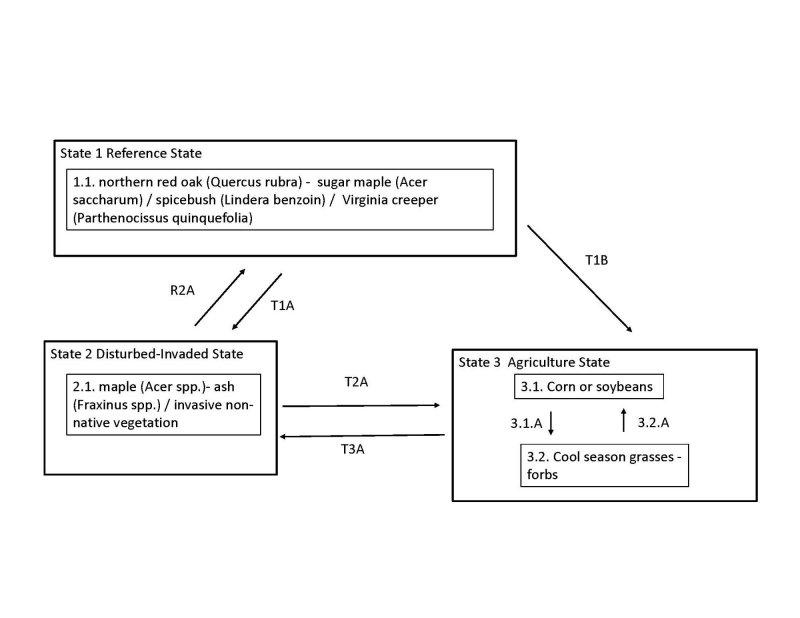
Natural Resources
Conservation Service
Ecological site F114XA502IN
Till Uplands
Last updated: 9/26/2024
Accessed: 12/20/2025
General information
Provisional. A provisional ecological site description has undergone quality control and quality assurance review. It contains a working state and transition model and enough information to identify the ecological site.
MLRA notes
Major Land Resource Area (MLRA): 114X–Southern Illinois and Indiana Thin Loess and Till Plain
MLRA 114A makes up about 4,550 square miles (11,795 square kilometers). The three parts of this MRLA are mostly in the Till Plains Section of the Central Lowland Province of the Interior Plains. The western third of the western part is in the Highland Rim Section of the Interior Low Plateaus Province of the Interior Plains. The eastern half of the eastern part is in the Kanawha Section of the Appalachian Plateaus Province of the Appalachian Highlands. Both large and small tributaries of the Ohio River dissect the nearly level to very steep glaciated uplands in this area. The major streams and rivers have well defined valleys with broad flood plains and numerous stream terraces. The flood plains along the smaller streams are narrow. Broad summits are nearly level to gently sloping. Elevation ranges from 320 feet (100 meters) on the southernmost flood plain along the Ohio River to 1,250 feet (380 meters) on the highest ridges. Local relief is mainly 10 to 50 feet (3 to 15 meters), but it can be 50 to 100 feet (15 to 30 meters) along drainageways and streams. Also, the Ohio River bluffs are as much as 300 feet (90 meters) above the river valley floor.
Classification relationships
USFS: 222 Eastern Broadleaf Forest (Continental) Province
Homoya's Natural Regions of Indiana: Bluegrass Region
The following NatureServe Explorer Ecological System has a high level of probability to match the ecological site found on these soils.
North-Central Interior Dry-Mesic Oak Forest and Woodland-CES202.046.
Southern Interior Low Plateau Dry-Mesic Oak Forest - CES202.898.
Ecological site concept
Till Upland Forest sites were historically a diverse and complex mosiac of forest species. High-quality, old-growth forest on wetter micro-sites exhibited wet oak forest species such as pin oak, swamp white oak, swamp chestnut oak, and sweetgum. However, most of these sites are characterized by more mesic forest species such as northern red oak, sugar maple, white ash, mockernut hickory, bitternut hickory, tulip poplar, and hickory. Overall, the soils in this group will present a wet-mesic to mesic upland deciduous forest complex dictated by soil drainage and restrictive layer depth.
The majority of sites today have a history of disturbance. Ruderal versions of this community are common. Sugar maple, tulip poplar, and beech have gained prominence on many sites.
Associated sites
| F114XA504IN |
Sloping Till Upland Forest Soils in the Sloping Till Upland Forest group are located higher on steeper slopes. |
|---|
Similar sites
| F114XA504IN |
Sloping Till Upland Forest The Sloping Till Upland Forest soils will share vegetative similarities including many species of trees. |
|---|
Table 1. Dominant plant species
| Tree |
(1) Quercus rubra |
|---|---|
| Shrub |
(1) Lindera benzoin |
| Herbaceous |
(1) Parthenocissus quinquefolia |
Click on box and path labels to scroll to the respective text.
| T1A | - | Disturbance; invasion of non-native plants |
|---|---|---|
| T1B | - | Clearing, brush removal, site prep, planting; and weed/brush control. |
| R2A | - | Brush control; weed control; planting of desired species |
| T2A | - | Tree and brush clearing; site preparation; tillage; seeding; weed control; agricultural management |
| T3A | - | Abandonment; no management inputs |
State 1 submodel, plant communities
State 2 submodel, plant communities
State 3 submodel, plant communities
| 3.1.A | - | Site preparation; seeding; weed control and brush control; grassland management |
|---|---|---|
| 3.2.A | - | Tillage; seeding; weed control |


